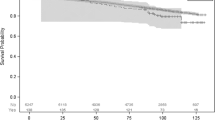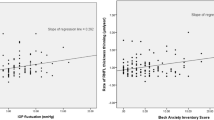Abstract
Objective
To investigate whether anxiety plays a role in self-recruitment for non-population-based glaucoma screening.
Methods
In a non-population-based pre-publicised trial, self-recruited Caucasian participants were screened for glaucoma, and also completed the Trait Anxiety Inventory and Shortened Health Anxiety Inventory questionnaires. In pre-publicity for the trial, information on risk factors for glaucoma was given. Participants classified as possible glaucoma cases later underwent a detailed glaucoma investigation.
Results
Of the 120 total participants (72 females, 48 males), 12 were considered glaucoma suspects at the screening, although only three (2.5%) were ultimately diagnosed with glaucoma. Health anxiety showed significant correlation with trait anxiety (r=0.525, P<0.001). Trait anxiety was similar for both the genders; this score was significantly below the normal Hungarian population value in women (P<0.001) and at the normal population level in men (P=0.560). In contrast, health anxiety was significantly higher than for both the ‘normal’ and ‘anxious’ reference groups (P<0.001), although smaller than that for hypochondriacs (P<0.001). Participants with pre-existing ocular symptoms, and those who attended because of fear of blindness, had significantly higher trait- and health-anxiety scores (P<0.05 for all comparisons).
Conclusion
In this screening trial, the health anxiety of the self-recruited participants was significantly above normal, whereas the prevalence of glaucoma was within the usual range for a Caucasian population. This suggests that providing pre-publicity information on risk factors for glaucoma does not necessarily increase the prevalence of glaucoma among self-recruited participants in non-population-based screening, as some individuals may participate on account of elevated health anxiety, rather than because of higher potential risk for glaucoma.
Similar content being viewed by others
Log in or create a free account to read this content
Gain free access to this article, as well as selected content from this journal and more on nature.com
or
References
Quigley HA, Broman AT . The number of people with glaucoma worldwide in 2010 and 2020. Br J Ophthalmol 2006; 90: 262–267.
The Eye Diseases Prevalence Research Group. Prevalence of open-angle glaucoma among adults in the United States. Arch Ophthalmol 2004; 122: 532–538.
Bonomi L, Marchini G, Marraffa M, Bernardi P, De Franco I, Perfetti S et al. Prevalence of glaucoma and intraocular pressure distribution in a defined population: The Egna-Neumarkt study. Ophthalmology 1998; 105: 209–215.
Tielsch JM, Sommer A, Katz J, Royall RM, Quigley HA, Javitt J . Racial variations in the prevalence of primary open-angle glaucoma: the Baltimore Eye survey. JAMA 1991; 266: 369–374.
Wolfs RCW, Borger PH, Ramrattan RS, Klaver CC, Hulsman CA, Hofman A et al. Changing views on open-angle glaucoma: definitions and prevalences—The Rotterdam study. Invest Ophthalmol Vis Sci 2000; 41: 3309–3321.
Antón A, Andrada MT, Mujica V, Calle MA, Portela J, Mayo A . Prevalence of primary open-angle glaucoma in a Spanish population: the Segovia study. J Glaucoma 2004; 13: 371–376.
Nizankowska MH, Kaczmarek R . Prevalence of glaucoma in the Wroclaw population. The Wroclaw epidemiological study. Ophthalmic Epidemiol 2005; 12: 363–371.
Quigley HA . Number of people with glaucoma worldwide. Br J Ophthalmol 1996; 80: 389–393.
Topouzis F, Coleman AL, Harris A, Koskosas A, Founti P, Gong G et al. Factors associated with undiagnosed open-angle glaucoma: the Thessaloniki Eye Study. Am J Ophthalmol 2008; 145: 327–335.
Wong EYH, Keeffe JE, Rait JL, Vu HT, Le A, McCarty C et al. Detection of undiagnosed glaucoma by eye health professionals. Ophthalmology 2004; 111: 1508–1514.
Quigley HA, Park CK, Tracey PA, Pollack IP . Community screening for eye disease by laypersons: the Hoffberger Program. Am J Ophthalmol 2002; 133: 386–392.
Wilson MR . Screening paradigms in glaucoma. J Glaucoma 2001; 10 (Suppl 1): S25–S27.
Tóth M, Kóthy P, Vargha P, Holló G . Accuracy of combined GDx-VCC and Matrix FDT in a glaucoma screening trial. J Glaucoma 2007; 16: 462–470.
Kumar S, Giubilato AG, Morgan W, Jitskaia L, Barry C, Bulsara M et al. Glaucoma screening: analysis of conventional and telemedicine-friendly devices. Clin Exp Ophthalmol 2007; 35: 237–243.
Harasymowycz PJ, Papamatheakis DG, Fansi AK, Gresset J, Lesk MR . Validity of screening for glaucomatous optic nerve damage using confocal scanning laser ophthalmoscopy (Heidelberg Retina Tomograph II) in high-risk populations: a pilot study. Ophthalmology 2005; 112: 2164–2171.
Hernandez R, Burr JM, Vale LD . Economic evaluation of screening for open angle glaucoma. Int J Technol Assess Health Care 2008; 24: 203–211.
Brown Sofiar J, Lehlbach M . The role of anxiety in a mammography screening program. Psychosomatics 2008; 49: 49–55.
European Glaucoma Society. Terminology and Guidelines for Glaucoma, 2nd ed. DOGMA s.r.l., Savona, 2008.
Sipos K, Sipos M . The development and validation of the Hungarian form of the STAI. In: Spielberger CD, Guerrero D (eds). Cross-Cultural Anxiety, 2nd ed. Hemisphere Publ. Corp.: Washington-London, 1978, pp 51–56.
Salkovskis PM, Rimes KA, Warwick HMC, Clark DM . The Health Anxiety Inventory: development and validation of scales for the measurement of health anxiety and hypochondriasis. Psychol Med 2002; 32: 843–853.
Rózsa S, Szádóczky E, Füredi J . Validation of the shortened version of BDI. Psychiatria Hungarica 2001; 16: 384–402.
Perczel Forintos D, Sallai J, Rózsa S . Reliability and validity of the Beck Hopeless Scale. Psychiatria Hungarica 2001; 16: 632–643.
Acknowledgements
The authors thank Márta Tóth for her assistance in the clinical examinations, and Cecilia Hlavács, Kornélia Németh, Katalin Lányi and Nikoletta Pázmándi for their assistance in administration and evaluation of the questionnaires. Supported by Hungarian National Health Grant (ETT) 001/2009 (Dr Holló).
Author information
Authors and Affiliations
Corresponding author
Ethics declarations
Competing interests
The author declares no conflict of interest..
Rights and permissions
About this article
Cite this article
Holló, G., Kóthy, P., Géczy, A. et al. Health anxiety in a non-population-based, pre-publicised glaucoma screening exercise. Eye 24, 699–705 (2010). https://doi.org/10.1038/eye.2009.131
Received:
Revised:
Accepted:
Published:
Issue date:
DOI: https://doi.org/10.1038/eye.2009.131



